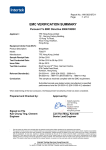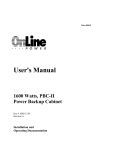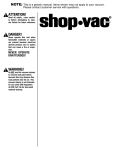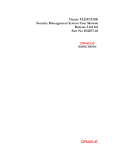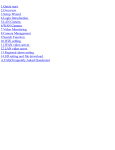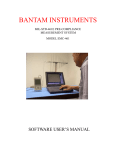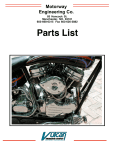Download 3000 series rts - American Vault Corporation
Transcript
TABLE OF CONTENTS Section 1. INTRODUCTION 1.1 1.2 1.3 1.4 2. INSTALLATION 2.1 2.2 2.3 2.4 2.5 3. Product Overview Teller Terminal Specification Customer Terminal Specification General Specification Unpacking Instructions Site Requirements Installation Procedure Wiring Diagrams Installation Drawings OPERATION 3.1 Switches and Indicators 3.1.1 3.1.2 3.1.3 3.1.4 3.1.5 3.1.6 3.1.7 3.1.8 3.1.9 3.1.10 Send Switch Home Switch Door Switch Tset Switch Send LED Home LED Customer Door Open LED Customer Door Closed LED Power Switch Customer Safety Switch I Operating Instructions PNEUMATIC TUBE SYSTEM MODEL 3000 TABLE OF CONTENTS (continued) Section 3.2 Functions 3.2.1 3.2.2 3.2.3 3.2.4 3.2.5 3.2.6 3.2.7 3.3 4. Sequence of Operation MAINTENANCE 4.1 4.2 5. Send Home Door Tset Customer Send Recall in Flight Shutdown Cleaning Preventative Maintenance SERVICE 5.1 5.2 5.3 5.4 5.5 5.6 5.7 5.8 Fault Analysis Troubleshooting Indicators for Customer P.C.B. and Teller pushbutton P.C.B. Troubleshooting indicators for Teller Terminal Control P.C.B. Troubleshooting Guide Teller terminal P.C.B. schematic Customer terminal P.C.B. schematic Teller terminal detail Customer terminal detail II DISCLAIMER The material in this manual is for information purposes only. The contents and the product described are subject to change without notice. The manufacturer makes no representations or warranties with respect to this manual. This product was designed for certain applications only. It may not be modified and/or used for any applications other than that which it was designed. The design specifications of the product described herein is subject to change without notice. The manufacturer reserves the right to make such changes without incurring any obligation to make them in units previously sold. Differences between the unit you received and the views contained herein are the result of design improvement and/or the addition of options as specified. WARNINGS Caution: If not properly installed, operated and maintained, the use of this equipment presents the possibility of personal injury or property damage. Before use, all persons who will install, operate or maintain this product should read this manual thoroughly. For safe, dependable performance, follow all instructions and recommendations contained herein. Caution: To prevent fire or shock, do not expose this product to rain or any type of moisture. Caution: Keep hands clear of moving parts. Caution: Always unplug unit from power source prior to cleaning or servicing unit. III 1 INTRODUCTION 1.1 Product overview This pneumatic tube system is a durable, field proven unit. It has been designed to provide easy access by both customer and teller, and reliable operation under harsh conditions. This pneumatic tube system is for overhead tube applications using the proven pull-both-directions method. Blowers are located in the canopy and insulated for quiet operation. This unit employs elevator style carrier delivery using an open frame platform on the teller end that does not block the tellers view. The standard unit is constructed of quality materials, including extensive use of stainless steel on external surfaces and zinc plating and galvanized steel for internal components. The unit is finished using attractive black trim and custom overlays. 1-1 1.2 TELLER TERMINAL SPECIFICATIONS MODEL 3100 TELLER UNIT WIRE ACCESS (2 PL) MOUNTING BOLT (3 PL) 5" 3 10 " 4 LEFT SIDE ELEVATION 1 1 " 4 3 7 " 8 WALL MOUNT BRACKET CARRIER PAD 7 1 " 8 24" 3 15 " 4 1 14 " 2 5" 13" 1 40 " 2 37" 1 3 " 2 PLAN 3 15 " 4 3 25 " 4 24" 1 9 " 8 SERVICE PANEL "T-SET" SWITCH (HIDDEN) SEND SWITCH HOME SWITCH DOOR SWITCH POWER SWITCH 3 8 " 8 3 7 " 8 FRONT ELEVATION (SHOWN WITH ELEVATOR PLATFORM UP) CUSTOMER TERMINAL SPECIFICATIONS MODEL 3200 CUSTOMER UNIT 5" SQ. CUTOUT FOR CONDUIT CUSTOMER UNIT OUTLINE 5" PLAN 1 2 " 2 5" BASE MOUNTING BOLT (4 PL) 3" (MOUNTING BASE) PLAN PENETRATION FOR OPTIONAL OVERHEAD CONDUIT (2 PL) 1 1/2" 3" 10" 3" OVERHEAD CARRIER TUBE 2" 3 13 " 4 1 5 " 4 CAMERA PORT (OPTIONAL) SEND BUTTON TELLER CALL BUTTON 39" 5 35 " 8 3 31 " 4 28" 7 25 " 8 1.3 AUDIO (SPEAKER/MIC) CARRIER DEPOSIT MOUNTING BOLT (4 PL) 20" FRONT ELEVATION 1.4 Specifications Power Requirements: Power Consumption Kiosk: Blowers: 120 VAC 5-/60 Hz. 2 Amps 9 Amps ea. Maximum package weight: Coins not recommended, otherwise limited only by space in carrier. Maximum carrier velocity: 40 feet per second 1-4 2 INSTALLATION 2.1 Unpacking and Inspection Open shipping carton and remove the contents. The carton should contain the following items: 1 ea. 1 ea. 1 ea. 1 ea. 2 ea. 2 ea. 2 ea. 2 ea. 1 ea. 1 ea. 1 ea. Customer Unit Customer Unit base Teller Unit Teller Unit Mounting bracket Carriers Steel radius w/port Blower assembly Blower hose User Manual Clear butyrate tubing 10’ Stick Hardware Kit: 1 ea. Butyrate/steel transition coupling 4 ea. Hose Clamp 3 ea. Bolt, hex head, 1/2-13 x 1” 4 ea. Lag Screw, hex head, 1/2” x 2” 10 ea. Flatwasher, 1/2” 4 ea. Bolt, Hex head, 3/8-16 x 3/4” 4 ea. Bolt, Hex head, 1/4-20 x 3/4” 4 ea. Wedge Anchor, 3/8” x 2 3/4” 4 ea. Lockwasher, split ring, 1/4” 4 ea. Flatwasher, 1/4” 2-1 2.2 Site Requirements The pneumatic tube system can be installed in most existing drive thru locations. Adequate support structure is required to support the pneumatic tube and blower packs above the drive thru. It is recommended that the structure be covered to protect the blowers and the customer kiosk from the weather. In the event that the blowers are mounted above the canopy, a weatherproof housing must be provided. Electrical power can be run underground or overhead. Underground installations require 4 ea. 3/4” conduits for maximum utilization of optional items, including CCTV cameras and heater. Overhead power applications use 2 ea. 3/4” conduits. One for 115 VAC power and the other for control, cctv, audio, low voltage power. Each blower pack must be supplied with 115 VAC power by means of a junction box and flex conduit to the blower pack. each lane must have 1 20 amp circuit for the customer kiosk and 1 30 amp circuit feeding two blower packs. Note: Reference section 2.5 for the Installation Drawing. 2-2 2.3 Installation Procedure The teller unit is installed by mounting the hanging bracket on the wall above the window. The G.C. should provide a 12” header capable of supporting the weight of the teller unit to secure the bracket to the wall. The teller unit is the attached to the bracket using supplied hardware. The customer unit base is anchored to the island using 3/8” wedge anchors. The base is positioned such that the 4 conduits are accessible through the 5” square cutout in the base. The base is leveled using leveler screws then secured using the anchor bolts. The customer unit is then lowered into place onto the mount and secured using supplied hardware. The steel tubing is cut and fit using standard fitting practices. Joints should be secured by welding then covered with heat shrink sleeve to prevent vacuum loss. Tubing should be braced to prevent excessive movement and possible stresses to joints. Blower packs are mounted near the radii above each end. The may be attached to any surface that will support their weight. Since many mounting options are possible, Mounting hardware is not supplied for the blower packs. Wiring of the units is covered in section 2.4, page 2-4 of this manual. 2-3 3 OPERATION 3.1 Switches and Indicators 3.1.1 Send Switch The send switch located on the teller control panel initiates a send cycle any time the system is not in the middle of a cycle. Regardless of the position of either door or the carrier. 3.1.2 Home Switch The home switch located on the teller control panel initiates a home cycle any time it is pushed. Even if the system is in the middle of a cycle, and regardless of the position of any doors or the carrier 3.1.3 Door Switch The door switch located on the teller control panel changes the current position of the customer door. This button is only active when no other cycles are active. 3.1.4 Tset Switch The Tset switch located on the teller control panel but not shown on the front overlay initiates a travel time set sequence. This process is described further in section 3.2.4 of this manual. 3.1.5 Send LED The send LED, located on the teller control panel above the send switch indicates that the carrier is being sent to the customer unit. 3.1.6 Home LED The home LED, located on the teller control panel above the home switch indicates that the carrier is coming into the teller unit. 3.1.7 Customer Door Open LED Located on the teller control panel above the door switch indicates that the customer door open limit switch is pressed. 3-1 3.1.8 Customer Door Closed LED Located on the teller control panel above the door switch indicates that the customer door closed limit switch is pressed. 3.1.9 Power Switch The power switch located on the bottom of the teller unit, Turns power off to the teller unit. This switch does not turn power off to the entire system. Main power is inside the customer unit. 3.1.10 Customer Safety Switch The customer safety switch, located across the top of the carrier deposit chamber, when pressed, causes the customer door to fully open and remain in that position until the teller presses the send, home or door button. 3.1.11 Customer Send Switch The customer send switch, located on the front of the customer unit, initiates a home cycle only upon the successful completion of a teller send cycle. 3.1.12 Call Switch The call switch, located on the front of the customer unit, Is part of the audio interface provided on the customer unit circuit board. Pressing this switch generates a call tone on the connected audio system. 3-2 3.2 Functions 3.2.1 Send The send function is used to move the carrier from the teller position to the customer position. When this switch is pressed, the control checks the position of the customer door. If the door is not closed, a signal is generated to close it. Next, the position of the teller elevator is checked, if it is not fully open, the door is closed then opened halfway, if the door is fully open, the door closes half way. Next, the send blower, located over the customer unit comes on pulling the carrier to the outside radius, the carrier then floats down to the customer unit. When the send blower time completes, the outside door opens then the teller door closes. This completes the send cycle. 3.2.2 Home The home function is used to move the carrier from the customer end to the teller end. When this switch is pressed, The teller door is closed if it not already closed. Next, The customer door is checked. if it is closed, it is opened halfway. If it is open, it is closed halfway. Next, the home blower is turned on. The carrier moves to the radius above the teller unit from there, it floats down to the teller unit. When the home blower timer completes, the teller door is opened then the customer door is closed. This completes the home cycle 3.2.3 Door The door function is used to change the position of the outside door. If the door is closed and the customer door closed LED on the teller control panel is lit, The door will open when the switch is pressed, otherwise, the door will close when pressed. When a send cycle has been completed and the door switch is pressed to close the outside door, The customer send function will be disabled until the door switch is pressed again to open the door or another send cycle is initiated 3-3 3.2.4 Tset This function is used to set the travel time of the carrier in both directions. 3.2.4.1 Setting the send time: 1. Press home and wait for the cycle to complete. 2. Place carrier in carrier deposit chamber. 3. Press and hold the Tset switch. Note: Do not release this button until step 6. 4. After 2 seconds, the send LED above the send switch will come on. 5. Press the send switch, this will cause the send LED to begin flashing. 6. Release the send switch and the tset switch. 7. Press the send switch and hold it until the carrier l ands outside. This will be indicated either visually or audibly. Continue holding the send switch for about half a second after the carrier lands to ensure that the carrier will have plenty of time to get there. 8. This completes the send time setting procedure. 3.2.4.1 Setting the home time: 1. Place carrier in carrier deposit chamber. 2. Press send and wait for the cycle to complete. 3. Press and hold the Tset switch. Note: Do not release this button until step 6. 4. After 2 seconds, the home LED above the home switch will come on. 5. Press the home switch, this will cause the home LED to begin flashing. 6. Release the home switch and the tset switch. 7. Press the home switch and hold it until the carrier lands inside.either visually or audibly. Continue holding the home switch for about half a second after the carrier lands to ensure that the carrier will have plenty of time to get there. 8. This completes the home time setting procedure. 3-4 3.2.5 Customer Send This function is used by the customer to move the carrier from the customer terminal to the ller terminal. This switch is only active after the successful completion of a send function. If the door switch on the teller control panel is pressed to close the customer door, Customer send switch is disabled until either the door switch is pressed to open the door or the teller send switch is pressed and the send cycle is completed. Once the customer send switch is recognized by the control, the sequence is identical to the home cycle. 3.2.6 Recall in Flight Recall in flight is possible because the home switch on the teller control panel is always enabled. When home switch is pressed, any cycle is stopped and a home cycle is initiated. this enables the teller to pull the carrier back at any time, even while the carrier is floating down to the customer unit. 3.2.7 Shutdown The shutdown function is actually a sequence of steps intended to seal the system for overnight protection. It is accomplished by first pressing home the wait for the home cycle to complete. Remove the carrier from the system and set aside. Press the send switch and wait for the cycle to complete. Press the door switch and observe the customer door closed LED. This seals the system to prevent vandalism and the formation of condensation. The power switch can now be switched off to protect the system from electrical surges. To power up the system, simply switch on the power and place the carrier in the system. 3-5 4 MAINTENANCE 4.1 Cleaning The customer and teller units should be cleaned with a stainless steel polish and a soft cloth. Any debris should be removed from the carrier deposit chambers as they could prevent proper operation of the system. Use of harsh solvents or acids could damage the finish of the system. 4.2 Preventative maintenance. There are no user serviceable parts in the customer or teller units and all service should be performed by authorized service personnel. The system should be serviced yearly to check the condition of drive components, and to remove any debris from the inside of the customer and teller units. The serviceman should check the motor, lead screw, drive nut and slides for signs of excessive wear, and replace if necessary. 4-1 5 SERVICE 5.1 Fault Analysis There are several indicators on the circuit boards which help in troubleshooting the Model 3000 Remote Teller System. they are outlined below. Customer Control Circuit Board. 1. Power LED. This LED indicates that the power supply at the customer unit is functioning properly. This power supply provides power to the customer door relays and the send and mute signals. 2. Open Relay LED. This LED lights when the open relay is energized. 3. Closed Relay LED. This LED lights when the close relay is energized. Teller Control Circuit Board. 4. +5 VDC LED. This LED is lit when +5 volts DC is present on the Teller Control Circuit Board. When lit, all AC voltages are most likely OK. 5. Watchdog LED. This LED should flash at a rate of 2 times per second. This light indicates the proper operation of the microcontroller. a constant on or off of this light would indicate a fault. 6. Open Relay LED. 7. Closed Relay LED. This LED lights when the close relay is energized. This LED lights when the open relay is energized. 8. Send Blower LED. When this LED is lit, the Send blower over the customer unit should be running. 9. Home Blower LED. When this LED is lit, the Home blower over the teller unit should be running. 5-1 5.1 Fault Analysis (cont’d) Teller Pushbutton Circuit Board. 10. Send LED. When this LED is lit, the Send blower over the customer unit should be running. 11. Home LED. unit should be running. When this LED is lit, the Home blower over the teller 12. Door Open LED. switch is activated. When this LED is lit, The customer door open limit 13. Door Closed LED. When this LED is lit, The customer door closed limit switch is activated. 5-2 5.2 TROUBLESHOOTING INDICATORS 12. DOOR CLOSED LED 13. DOOR OPEN LED 11. HOME LED 10. SEND LED LOCATION OF HIDDEN TSET BUTTON 1. POWER LED MANUAL CLOSE PUSHBUTTON MANUAL OPEN PUSHBUTTON 24 VAC IN 2. OPEN RELAY LED 3. CLOSE RELAY LED 5.3 TROUBLESHOOTING INDICATORS 24 VAC FROM CUSTOMER UNIT MOTOR FUSE 6. OPEN RELAY LED 7. CLOSE RELAY LED 8. SEND BLOWER LED SYSTEM FUSE 9. HOME BLOWER LED 5. WATCHDOG LED 4. +5 VDC LED Section 5.4 Troubleshooting Guide Symptom Checks Corrective Action Unit Won’t Power Up 110 VAC Power Check 110 VAC Power to transformer. 24 VAC Power Check for 24 VAC throughout system up to teller board. Fuses Check fuses on transformer and on teller circuit board. Wiring check wiring on transformer and between customer and teller units. Also check wiring to power switch at teller unit. Customer Board Check board for bad connectors or damaged traces on back of board. Teller Board Check for damaged connectors or traces on teller board. Check for Red LED (DS2) which indicates +5 VDC and the Green flashing LED (DS2) which indicates that the processor is running. Power Switch check for continuity in the switch. 5-5 Troubleshooting Guide Symptom Checks Corrective Action Customer Door Won’t Move Attempt manual operation. unplug the unit then restore power. Use the manual switches to check door operation. Power Ensure that 24 VAC power is present at the Customer board. this is indicated by the Power LED on the customer board. This voltage should also be verified to be 24 - 28 VAC. Fuses Check the 10 Amp fuse (F1) on the customer circuit board. Relays Observe Open and Close LED’s while pressing manual switches. If the LED’s light, listen for the relays pulling in. If relays don’t pull in, replace circuit board. Limit Switches Power for the motor must flow through the limit switch in the direction it is moving. Make sure that the limit switch connections are good and that the switch has continuity. Wiring Check all wiring and connections in the limit switch and motor harness. Check closely for flared out connectors which may appear OK but may not be making contact. Capacitor If the capacitor is bad, the motor will hum but will not move. both motor wires must be connected to the capacitor for the motor to run. however, when the motor will only run in one direction, it is possible that one of the wires from the capacitor to the board may be at fault. 5-6 Troubleshooting Guide Symptom Checks Corrective Action Customer Door Won’t Move Gearmotor The motor lead resistance should be 2-4 Ohms from black to white and red. If motor is running but the output shaft is not turning, the gearbox may be defective. If the motor is hot, a thermal limit may have tripped and the cause of overheating should be investigated. Coupling Inspect coupling to ensure that connection to motor and lead screw is secure. Lead Screw Drive Remove Motor. While removing Lead Screw, note any excessive force required to unscrew lead screw from drive nut. Elevator Platform Move platform up and down by hand to ensure that mechanism moves freely and doesn’t bind. Power Ensure that 24 VAC power is present at the Teller board. This voltage be verified to be 24 - 28 VAC. Fuses Check the 10 Amp fuse (F2) on the teller circuit board. Relays Observe Open and Close LED’s after pressing the Home switch. If the LED’s light, listen for the relays pulling in. If relays don’t pull in, replace circuit board. Limit Switches Power for the motor must flow through the limit switch in the direction it is moving. Make sure that the limit switch connections are good and that the switch has continuity. (continued) Teller Door Won’t Move 5-7 Troubleshooting Guide Symptom Checks Corrective Action Teller Door Won’t Move Wiring Check all wiring and connections in the limit switch and motor harness. Check closely for flared out connectors which may appear OK but may not be making contact. Capacitor If the capacitor is bad, the motor will hum but will not move. both motor wires must be connected to the capacitor for the motor to run. however, when the motor will only run in one direction, it is possible that one of the wires from the capacitor to the board may be at fault. Gearmotor The motor lead resistance should be 2-4 Ohms from black to white and red. If motor is running but the output shaft is not turning, the gearbox may be defective. If the motor is hot, a thermal limit may have tripped and the cause of overheating should be investigated. Coupling Inspect coupling to ensure that connection to motor and lead screw is secure. Lead Screw Drive Remove Motor. While removing Lead Screw, note any excessive force required to unscrew lead screw from drive nut. Elevator Platform Move platform up and down by hand to ensure that mechanism moves freely and doesn’t bind. (continued) 5-8 Troubleshooting Guide Symptom Checks Corrective Action System Doesn’t Respond to Teller pushbuttons Teller pushbutton circuit board Inspect circuit board for damaged buttons or traces Flexible ribbon cable Inspect cable for creases or tears. Failure of this item may result in an intermittent condition best diagnosed by pressing the send button then manipulating the cable. Fixed ribbon cable This cable can be tested by the process of elimination. the pushbutton board can be removed and connected directly to the flexible ribbon cable thereby bypassing the fixed cable If the three items above are not at fault, replace teller control circuit board part number 3104C Teller control circuit board Blowers Don’t Come on Teller control circuit board Check Send blower and Home blower LED’s to see if they light up. If they don’t, replace board. Power Verify that blowers are connected to 110 VAC power in the canopy. Wiring Check wiring for proper connection and continuity. Blower Motor Check blower motor by bypassing solid state relay and powering the motor directly. You MUST disconnect power while rewiring blower. failure to do so could result in injury or death. Solid state relay If bypassing the relay allows motor to run, and all others tests have not found a problem, The relay should be changed. 5-9 5.7 TELLER TERMINAL DETAIL MOTOR UPPER BOARD COVER TELLER CONTROL P.C.B. FLEXIBLE RIBBON CABLE COUPLING CLOSED LIMIT SWITCH FIXED RIBBON CABLE DRIVE NUT LEAD SCREW LOWER BOARD COVER OPEN LIMIT SWITCH LANDING PAD TELLER PUSHBUTTON P.C.B. OVERLAY 5.8 CUSTOMER TERMINAL DETAIL BUTYRATE TUBE TRANSITION SAFETY SWITCH CARRIER CHAMBER CAMERA PORT CALL SEND SPEAKER CLOSED LIMIT SWITCH LEAD SCREW CUSTOMER TERMINAL CIRCUIT BOARD DRIVE NUT TRANSFORMER OPEN LIMIT SWITCH COUPLING MOTOR CAPACITOR CASE FRAME




























